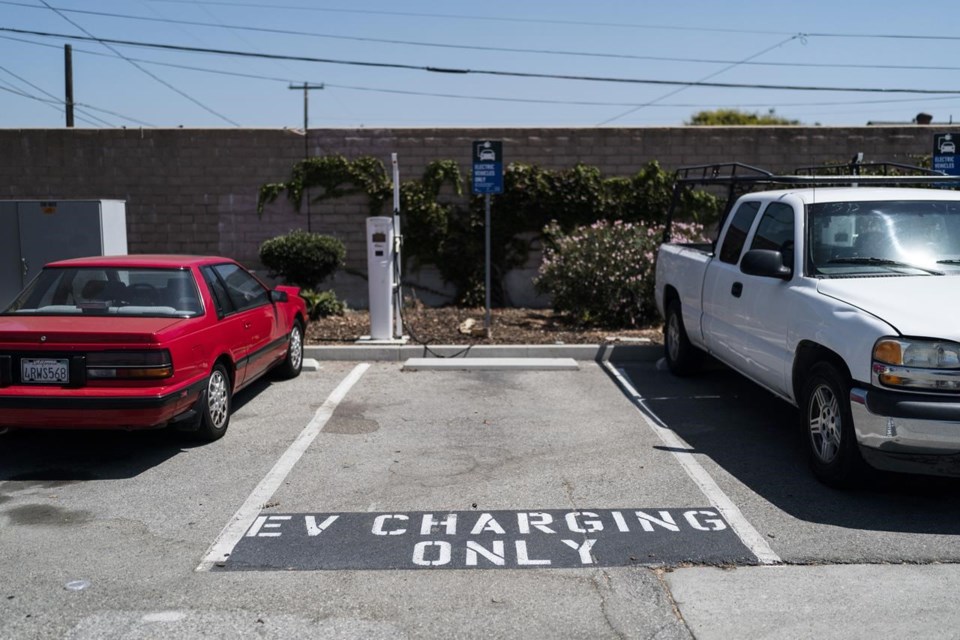SACRAMENTO, Calif. (AP) — Discounted prices, car-share programs and at least one million more public charging stations are among the ways California will try to make electric cars easier to buy and drive as it phases out the sale of gas-powered cars.
But the state won't force automakers to participate in any equity programs designed to ensure people of all income levels can buy electric cars.
“This rule had the opportunity to really set the path for lower income households to have increased access and affordability (for) electric vehicles, but it missed the mark,” said Roman Partida-Lopez, legal counsel for transportation equity with The Greenlining Institute.
Instead, car companies will get extra credit toward their sales quotas if they make cars available to car share or other programs aimed at disadvantaged Californians. Democratic Gov. Gavin Newsom has pledged $10 billion over six years for incentives to get electric vehicles into the hands of low-income residents, charging infrastructure, and other efforts to put cleaner cars and trucks on the road.
The Stockton Mobility Collective is one example. Designed to increase transportation options in disadvantaged parts of the city, the collective will set up five to seven neighborhood charging stations with 30 electric cars people can rent out on an hourly or daily basis. The first cars and charging stations launched last week in an apartment complex. The program got $7.4 million from the state.
Car ownership in South Stockton is low, so interest in the program is high, said Christine Corrales, senior regional planner for the program. But its just the first step in what must be a major effort to make electric vehicles a realistic option for lower-income Californians.
“If the infrastructure is not available locally, it may be challenging to encourage people to adopt and switch over," she said. “That's something that we're trying to be proactive about."
The regulations passed by the California Air Resources Board last week say that 2035 the state will require automakers to sell only cars that run on electricity or hydrogen, though some can be plug-in hybrids that use gas and batteries. People will still be able to buy used cars that run on gas, and car companies will still sell some plug-in hybrids. Beyond questions of affordability and access, the state will need to overcome skepticism of people who think electric cars simply aren’t for them.
“We’ve got to get past the elitism that’s involved with owning an electric car,” said Daniel Myatt, who brought an electric car in 2020 through the state’s Clean Cars 4 All program, which he qualified for when he was out of work due to an illness.
Since 2015, more than 13,000 electric cars have been purchased through the program. It offers people up to $9,500 for people to trade in their gas cars for electric or hybrid models.
About 38% of the money spent on a separate rebate program has gone toward low-income or disadvantaged communities, and the state has spent hundreds of millions of dollars building charging stations in those neighborhoods. Today, though, there are just 80,000 public charging stations around the state, far short of the 1.2 million the state estimates it needs by 2030.
Under the new regulations, car makers can get extra credit toward their sales quotas if they participate in several equity programs.
Those programs include: Selling cars at a discount to car-share or other community programs; making sure cars that come off lease go to California dealers that participate in trade-in programs; or selling cars at a discounted price. To meet the third option, cars would have to cost less than $20,275 and light-duty trucks less than $26,670 to qualify for the extra credit. It only applies to model years 2026 through 2028, and there's no restriction on who those cars can be sold to.
Southern California EVen Access is using a $2.5 million state grant to install at least 120 chargers across a 12-county region, at apartment complexes and public places like library parking lots. Apartment complex owners can get $2,500 per charger installed on the property.
Overall, the state should do more public messaging about the programs that are available to buy electric vehicles so that all communities can enjoy the benefits of fewer cars that spew emissions and pollution, said Lujuana Medina, environmental initiatives manager for Los Angeles County. The state must also invest in a workforce that can support an electric transportation economy, she said.
“There will have to be some really progressive public purpose programs that help drive electric vehicle adoption and sales,” she said.
Alicia Young of Santa Clara, California, was unsure when she first heard about the state's trade-in program. But she eventually pursued the deal, leaving behind her 2006 Nissan for a plug-in hybrid from Ford. It cost $9,000 after her trade-in value.
The car runs more smoothly and just as fast as any gas-powered car she's ever owned. She mostly runs it on battery charges, though she still fills the gas tank about once a month. The apartment complex where she lives with her mother does not have a car charger, so she often relies on charging stations at the grocery store or other public places.
She's shared information about the trade-in program with her colleagues at the senior retirement center where she works, but many of them seem mistrustful, she said. The state could speed adoption by having public messengers from a wide variety of backgrounds to help build trust in electric cars, she said.
“It's a little bit different at first, but that's normal with any new car," she said.
Kathleen Ronayne, The Associated Press



